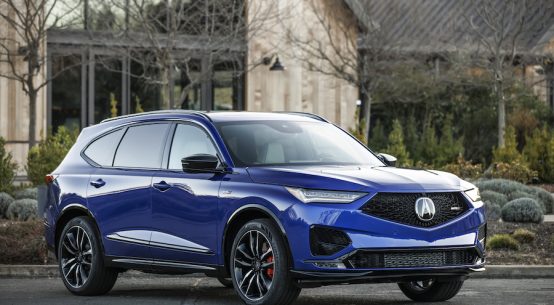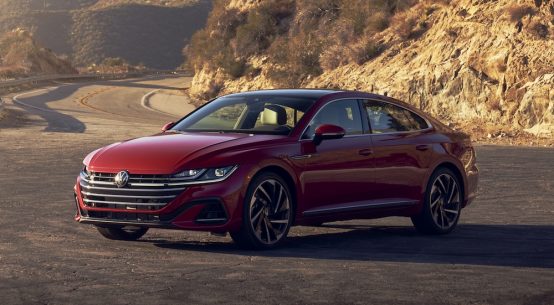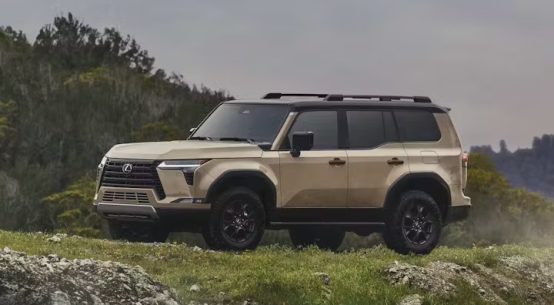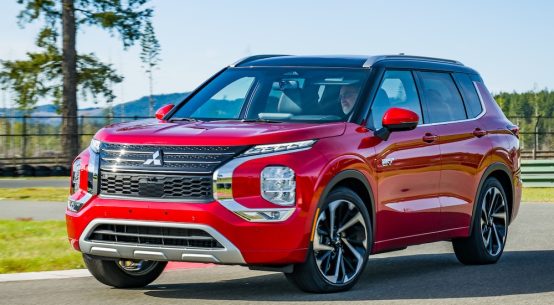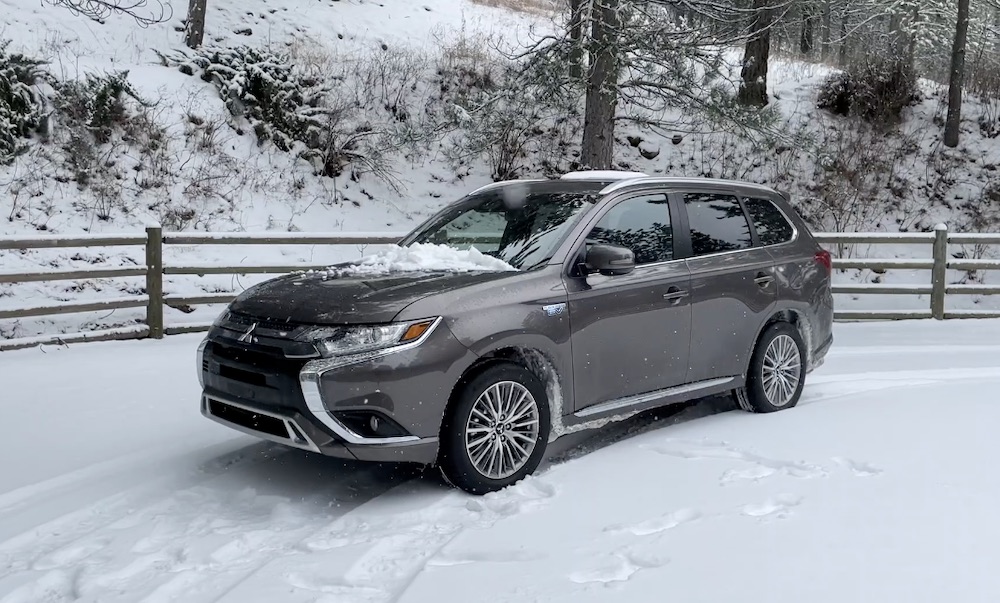
The Mitsubishi Outlander PHEV (plug-in hybrid electric vehicle) receives a new 2.4-liter gasoline 4-cylinder engine this model year, replacing the outgoing 2.0-liter unit. A more potent electric motor and a more powerful battery are also new for 2021.
As a result, the Outlander PHEV enjoys improved performance… horsepower goes from 117 to 133 and a boost from 80 hp to 93 hp in a pair of rear engines. It’s all-electric driving range is better too. The 2021 model’s battery pack improves from 12 kWh to 13.8 kWh, doubling its current all-electric range of 22 miles to 44 miles. The PHEV comes in two trims, SEL and GT, each with Super AWC.
Standard features with our SEL include 18-inch alloy wheels, automatic headlights, foglights, heated side mirrors, automatic wipers, a power liftgate, keyless entry, push-button start, leather upholstery, power-adjustable heated front seats, 60/40-split folding and reclining rear seats, dual-zone automatic climate control, a rearview camera, voice controls, Bluetooth, a six-speaker sound system, an 8-inch touchscreen display, three USB ports, and Apple CarPlay and Android Auto smartphone integration. Driver safety aids include forward collision alert with pedestrian detection, automatic emergency braking, lane departure warning, blind-spot monitoring, rear cross-traffic alert and automatic high beams.
Stepping up to the GT adds LED headlights, a sunroof, a heated steering wheel, a multiview camera, dual AC power outlets (replacing the rear USB ports), adaptive cruise control, and an upgraded sound system. To that, the new GT Premium Interior package can be added and includes premium leather upholstery and a few black interior treatments.
Cargo behind the back row is generous at 30.4-cubic-feet. With the back row folded down, you’ll find up to 66.6 cubic feet of space, which is a decent amount for this type of SUV.
The PHEV will be the only Outlander version sold for the 2021 model year while everyone waits for the new 2022 model.
Three Drive System Modes
Thanks to its unique drivetrain, which combines a front electric motor, rear electric motor, and front-mounted gasoline-powered 2.0-liter engine with integrated generator, the 2020 Mitsubishi Outlander PHEV is able to operate in one of three unique drivetrain modes for optimal performance and efficiency:
EV Drive Mode (Twin Motor S-AWC EV)
In EV Drive Mode, the vehicle is driven by the two electric motors, with energy being supplied exclusively by the lithium-ion battery pack. With the EV mode button, the driver can select this driving mode when they desire 100% electric-powered, zero-emission driving, for up to 22 miles.
Series Hybrid Mode (Twin Motor S-AWC EV with Internal Combustion Generator)
When the energy level remaining in the lithium-ion battery pack is low, the two electric motors are powered by the battery pack and the gasoline-powered generator.
In this configuration, the gasoline-powered generator helps:
1) Charge the lithium-ion drive battery pack
2) Provide power to the twin electric motors
Parallel Hybrid Mode (Gasoline-Powered Engine Supported by Twin Motor S-AWC)
In this drive mode, the Outlander PHEV uses its full complement of available resources:
1) The 2.0-liter gasoline engine drives the front wheels; the front axle features a built-in clutch that switches the system to Parallel Drive Mode mainly for engine-powered travel at high speeds/steady-state cruise.
2) The two electric motors operate seamlessly when additional power is required, such as driving uphill.
3) The gasoline-powered engine/generator – while operating the vehicle at sufficient speed – will feed any excess energy (electricity) back into the lithium-ion battery pack.
The Parallel Hybrid mode is most commonly engaged when the Outlander PHEV is being driven in a long-haul/high-speed steady-state cruise manner, such as on the open road or interstate, where this drivetrain configuration is most efficient.
Driver Selected Modes
ECO Mode
The Outlander PHEV features a driver-activated “ECO Mode” switch that reduces both fuel and electricity usage for increased efficiency simply with the touch of the button in the center of the dash.
Battery Save Mode
In this driver-activated mode, the Outlander PHEV automatically conserves the energy within the lithium-ion drive battery pack by operating the vehicle in hybrid mode (note: Battery Save Mode will only operate once the lithium-ion drive battery pack’s energy level falls below 90 percent full). For example, engaging the Battery Save Mode would allow the vehicle to be driven in urban traffic with the engine/generator on to maintain a higher level of battery charge; it could then be deactivated, allowing the vehicle to be driven through a neighborhood silently at an appropriate speed in EV Drive Mode.
Battery Charge Mode
When activating the Battery Charge Mode – whether the vehicle is in motion or at a standstill – the engine will generate electricity to be fed into the lithium-ion battery pack (essentially forcing the vehicle to operate in Series Hybrid Mode). For example, if the engine is idling and the vehicle is not moving, selecting the Battery Charge Mode will replenish a low energy level within the lithium-ion drive battery pack back up to 80% fully charged in approximately 40 minutes.
The advantage to the Battery Charge Mode is that it ensures a reserve of additional power when necessary, such as for hill-climbing or towing.
PHEV System with Twin Electric Motor All-Wheel Control
With two full-time, high-output electric motors separately mounted at the front and rear axles to instantly supply torque on demand to all four wheels, the Outlander PHEV offers incredibly responsive performance. The front electric motor is positioned transaxle-style on the left side of the gas engine and has an output of 60 kW. The front motor is a higher output enhanced version of the permanent magnet synchronous electric motor used in the Mitsubishi i-MiEV.
The front-mounted generator converts mechanical power to electricity and continuously charges the drive battery, while a Power Drive Unit (PDU) helps to convert the electric power and send it to the front motor.
The rear 60 kW motor and Electric Motor Control Unit (EMCU) are mounted beneath the rear cargo area subfloor. Both the front PDU and rear EMCU are intelligent control units that contribute to heightened energy efficiency and optimal motor control.
Electricity for the drive motors is stored and supplied by a high-capacity lithium-ion battery pack developed specifically for the PHEV system. The battery pack consists of 80 cells configured in a series, with a total voltage measuring 300V and a total storage capacity of 12kWh. The battery is located in a dust-proof and waterproof casing positioned beneath the passenger compartment subfloor and between the front and rear axles, and does not intrude into the passenger compartment whatsoever.
Regenerative braking is also used to generate electricity for the system. During deceleration (braking), the front and rear electric motors function as generators so that electricity can be generated and fed back into the lithium-ion drive battery pack. Regenerative braking occurs when the vehicle is in motion while the accelerator pedal is not being pressed (coasting) or when the driver engages the brakes by pressing the brake pedal. Five levels of regenerative braking can be selected by the driver at any time using the standard steering wheel paddle-shifters.
S-AWC Produces Smooth Linear Response
The Outlander PHEV comes standard with Mitsubishi’s proprietary S-AWC. The S-AWC system found on the Outlander PHEV is a specialized application of the Lancer Evolution-derived Super All-Wheel Control, but in this case, developed specifically for the Outlander PHEV’s unique twin electric motor configuration. It provides maximum performance, efficiency, tractability and safety.
By optimally managing Active Yaw Control (AYC), Anti-lock braking system (ABS) and Active Stability Control (ASC) with Traction Control (TCL) — which now offers enhanced traction on all road conditions — the integrated control system brings out the full potential of Twin Motor S-AWC without compromising safety, comfort or fuel efficiency. When desired, the driver can manually engage the Twin-Motor 4WD LOCK button to simulate locking of a center differential and optimally distribute torque to all four wheels to maximize traction.
Easy Charging with Standard DC Fast-Charging Capability
Charging the Outlander PHEV is simple, with three different methods to choose from depending on location and/or needs. The vehicle’s drive battery can be charged with a standard 120V (full charge in eight hours) power outlet at home with the supplied charging cable, or with a public or residential 240V (full charge in less than four hours) charging station.
Outlander PHEV also comes standard with DC Fast-Charging capability and is the only Plug-in Hybrid SUV on the market offering this feature. Using this system at commercial charging facilities, the vehicle will charge up to 80 percent capacity in as little as 25 minutes. Charging status is conveniently displayed on the instrument panel.
Technology for All Around Safety
Available advanced safety technology supports safer, more confident driving — on the road and in parking lots, day and night. From intelligent sensors that track the vehicle’s surroundings and warn of danger to available active driving assistance and solid passive protection, the Outlander PHEV delivers.
- Blind Spot Warning (BSW)2 – This standard safety feature uses radar sensors in the rear bumper to detect vehicles in rear blind spots, on the right and left sides. An indicator appears in the door mirror when BSW is active and the turn signals are off. When a vehicle is detected and the turn signals are on, an indicator blinks in the door mirror on that side.
- Rear Cross Traffic Alert (RCTA)2 – Standard on all Outlander PHEV trims for 2020, an indicator appears in the combination meter display when RCTA is active. If radar sensors in the rear bumper detect an approaching vehicle nearby while reverse gear is engaged, a warning message appears in the multi-information display, an audible alert sounds and an indicator blinks in both exterior door mirrors.
- Forward Collision Mitigation (FCM)3 – Standard on all Outlander PHEV trims for 2020, FCM helps prevent a frontal collision or reduce the severity of that collision if it becomes unavoidable.
- Lane Departure Warning (LDW)4 – The Lane Departure Warning (LDW) system uses an onboard camera to monitor lane position in front of the vehicle audibly and visually, alerting the driver if it detects the vehicle leaving its lane unintentionally. (Standard on GT trim.)
- Automatic High Beam (AHB)5 – Standard on all Outlander PHEV trims for 2020, the high beams automatically switch to low beams when vehicles are detected ahead and automatically switch back to high beams, so the driver doesn’t have to remove their hand from the steering wheel to switch the beams manually.
- Multi-View Camera System6 – The views from cameras mounted on the front, rear and sides of the vehicle (including a bird’s-eye view) can be displayed in various combinations to help reveal what is in blind spots and help you park. (Standard on GT trim.)
- Adaptive Cruise Control System (ACC)7 – Optional feature that maintains a selected distance between the vehicle and the car ahead via radar for greater safety and peace of mind. (Standard on GT trim)
